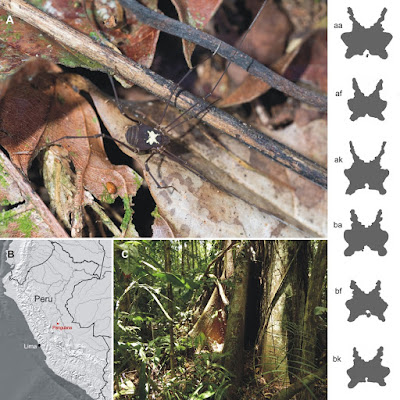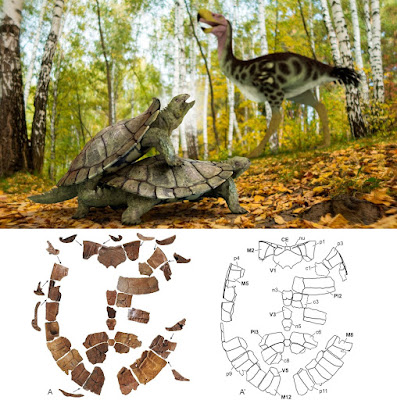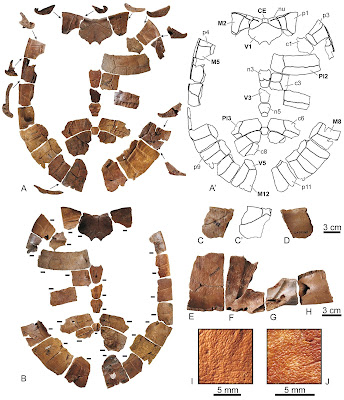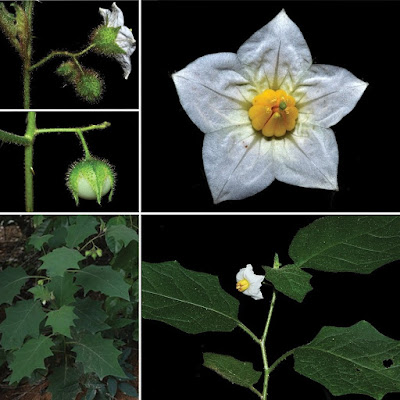[Most Recent Entries] [Calendar View]
Monday, February 3rd, 2020
| Time | Event | ||||
| 3:53a | [Arachnida • 2020] Taito adrik • A New Harvestman Species (Opiliones: Laniatores: Cosmetidae) from the Área de Conservación Privada Panguana, Peruvian Amazonia
Abstract A new species of the cosmetid harvestman genus Taito Kury & Barros 2014 is described from the Área de Conservación Privada (ACP) Panguana, Peruvian Amazonia, which extends the distribution range of the genus to the south-west. The herein described species Taito adrik sp. nov. differs from all other known species of the genus by the distinct shape of the equuleus, the armature of leg IV in males, and the structure of male genitalia, in combination with features of the chelicerae and the anal operculum. In addition, COI barcodes of the new species are provided. Keywords: Opiliones, Neotropics, primary rainforest, Opiliones, new species, COI barcode
Taito adrik sp. nov. Diagnosis. Dorsal scutum sturdy (average ratio length/width ca. 1.18 in females, ca. 1.21 in males), β-type (normal β) (Kury et al. 2007) and not βL-type (elongate β) (Kury & Medrano 2016) (Fig. 2 A). Equuleus butterflyshaped with discrete feet and arms, and elongated, slim horns (Figs. 1 A; 2 A, C; 3); two whitish blots on minute tubercles at posterior margin of scutal area III (in some specimens two smaller additional blots beside) (Figs. 1 A; 2 A, C). Groin warts (Kury & Barros 2014) on dorso-proximal part of coxa IV (Fig. 2 A, B), coxa IV with dorsal triangular apophysis (Fig. 2 F). Leg IV of male: femur IV gently curved with comb of five to six curved apophyses on distal-prolateral side; patella IV with coarse granules and one single apophysis proximal-retrolateral; tibia IV unarmed, covered with granules (Figs. 2 E, F; 5). Etymology. The specific name is an indeclinable noun in apposition, given in honour of the outstanding arachnologist Adriano B. Kury (nickname “Adrik”), who established the genus Taito, together with Carla M.L. Barros, in 2014. As professor and senior curator of arachnids in the Museu Nacional/UFRJ, Rio de Janeiro, Brazil, he lost most of his invaluable collections and fruits of his many field trips through the fire catastrophe in September 2018. Distribution. Only known from the type locality (Fig. 1 B). This extends the distribution range of the genus Taito to the south-west. So far, the genus was known from the Upper Amazon Basin up the eastern slope of the Andes. Now, the distribution reaches to a territory west of the Ucayali River, into the Pachitea Basin, which is located between the eastern slopes of the Andes and the Sira Mountains (Fig. 1 B). Stefan Friedrich and Tobias Lehmann. 2020. Taito adrik, A New Harvestman Species from the Área de Conservación Privada Panguana, Peruvian Amazonia (Opiliones: Laniatores: Cosmetidae). Zootaxa. 4729(1); 105–115. DOI: 10.11646/zootaxa.4729.1.7 | ||||
| 10:40a | [Paleontology • 2020] Laurasichersis relicta • Surviving the Cretaceous-Paleogene Mass Extinction Event: A Terrestrial Stem Turtle in the Cenozoic of Laurasia
Abstract Findings of terrestrial stem turtles are not uncommon at Mesozoic continental sites in Laurasia, especially during the Upper Cretaceous. Thus, the record of several lineages is known in uppermost Cretaceous ecosystems in North America (Helochelydridae), Europe (Helochelydridae and Kallokibotion) and Asia (Sichuanchelyidae). No terrestrial stem turtle had been described in Laurasia after the Cretaceous-Paleogene mass extinction event. Thus, the only representatives described in the Cenozoic record worldwide corresponded to forms from southern Gondwana, where some of them survived until the Holocene. A bizarre terrestrial stem turtle from the upper Thanetian (upper Paleocene) of Europe is described here: Laurasichersis relicta gen. et sp. nov. Despite its discovery in France, in Mont de Berru (Marne), this Laurasian taxon is not recognized as a member of a European clade that survived the Cretaceous-Paleogene extinction event. It belongs to Sichuanchelyidae, a hitherto exclusively Asian Mesozoic group, known from the Middle Jurassic. Finds at the Belgian site of Hainin (Hainaut) show that this dispersion from Asia and the occupation of some niches previously dominated by European Mesozoic terrestrial stem forms had already taken place a few million years after the mass extinction event, at the end of the lower Paleocene. Systematic paleontology Testudinata Klein, 1760 Mesochelydia Joyce, 2017 Perichelydia Joyce, 2017 Sichuanchelyidae Tong et al., 2012 Laurasichersis relicta gen. et sp. nov. Locality and Horizon: Mouras quarry, Mont de Berru, Berru, Marne, France. Sables de Bracheux Formation, Franco-Belgian Basin. MP6a, upper Thanetian, upper Paleocene. Etymology: The generic name is composed by Laurasi-, referring to Laurasia, where this taxon comes from; and –chersis, a Latinized word of Greek origin (Χέρσος) which means “land or dry land”, following the criteria used to establish the generic names of some other terrestrial stem turtles. The specific name refers to the fact that the new taxon is a vestige of Mesozoic fauna, being the only known Laurasian post-Mesozoic terrestrial stem turtle. Diagnosis: Sichuanchelyid defined by the following characters exclusive within this clade: dorsally directed distal margin of the anterior and middle peripherals, and antero-lateral margins of the nuchal; slightly wider than long nuchal; high bridge peripherals; second to fourth vertebrals narrower than the first one, and than the second and third pleurals; concave anterior plastral margin; epiplastra divided into four elements, acquiring an exclusive morphology; supernumerary xiphiplastra, divided into two elements; humeral-pectoral sulcus at the level of the axillary notch; absence of a complete inframarginal series, but presence of axillar and inguinal scutes; anterior and posterior pairs of ventral foramina for the carotids closer to each other than between the foramina that form each pair. This sichuanchelyid shows the following unique character combination: shell size greater than 60 cm; second costal as long as the first; absence of contact and long distance between the nuchal postero-lateral end and the second peripherals; first vertebral wider than the nuchal; contact of the first vertebral with the second marginals; pleural-marginal sulci on the proximal region of the peripherals; anterior end of the axillary buttress reaching the anterior half of the third peripherals; absence of plastral fontanelles; absence of strongly interfingered plastral contacts; supernumerary epiplastra; long epiplastral symphysis relative to the entoplastron length; gulars overlapping the antero-medial entoplastral area; wide exposure of the squamosals on the skull table; absence of palatal teeth; absence of ventral exposure of the prootics; narrow and deep depression between the tubercula basioccipitale; short basicranium in relation to its width; absence of cleithrum processes. Adán Pérez-García. 2020. Surviving the Cretaceous-Paleogene Mass Extinction Event: A Terrestrial Stem Turtle in the Cenozoic of Laurasia. Scientific Reports. 10: 1489. DOI: 10.1038/s41598-020-58511-8 One single primitive turtle resisted mass extinction in the northern hemisphere | ||||
| 2:34p | [Botany • 2020] Solanum hydroides (Solanaceae) • A Prickly Novelty from the Land of the Sugar Loaves, central Brazilian Atlantic Forest
Abstract Solanum hydroides Gouvêa & Giacomin, sp. nov., is described from central Brazilian Atlantic Forest. It is known from only three localities in Espírito Santo and Minas Gerais states, where granitic/gneissic outcrops (inselbergs or sugar loaves) are ubiquitous. The new species, here described, belongs to Solanum subgenus Leptostemonum (or the Leptostemonum clade; i.e. the spiny solanums) and is morphologically related to S. hexandrum Vell. and S. sublentum Hiern, with which it shares the shrubby habit, decurrent leaf bases and well-developed calyces that become accrescent, covering glabrous fruits. Solanum hydroides is unique in its combination of comparatively more delicate habit, indumentum of exclusively stellate eglandular trichomes, accrescent but never inflated fruiting calyces that only partially cover the fruits and comparatively shortly lobed and strictly white corollas. The species is threatened with extinction and assessed as Vulnerable (VU), based on the IUCN criteria. Keywords: Leptostemonum clade, Brazil, inselbergs, new species, eglandular trichomes Solanum hydroides Gouvêa & Giacomin, sp. nov. Diagnosis: Differs from S. sublentum Hiern in its indumentum of strictly stellate eglandular trichomes and in its accrescent, but not inflated, cupuliform fruiting calyx; also differs from S. hexandrum Vell. in its more delicate habit, smaller flowers with white shallowly stellate corollas and in having accrescent, but not inflated, fruiting calyces that partially cover the mature fruits. Distribution: Endemic to South-eastern Brazil, with records in three localities in north-eastern Minas Gerais (Mun. Teófilo Otoni) and northern (Mun. Nova Venécia) and central (Mun. Santa Teresa) Espírito Santo States (Fig. 2). Ecology: Solanum hydroides inhabits the edge of seasonal semi-deciduous tropical rainforests associated with granitic or gneissic rock outcrops (inselbergs) and somewhat disturbed sites at their base, like roadsides and clearings; from 300 to 600 m elevation. It also occasionally grows in epilithic vegetation patches lying on the flatter parts of inselbergs. Etymology: Solanum hydroides is named for the resemblance of the long-stalked stellate trichomes of its calyces to the marine serpulid worm Hydroides Gunnerus, 1768 (illustrative images can be found at the Encyclopedia of Life; e.g. https://eol.org/search?utf88=✓&q=Hydroides). Yuri Fernandes Gouvêa, Luiza Fonseca Amorim de Paula, João Renato Stehmann and Leandro Lacerda Giacomin. 2020. Solanum hydroides (Solanaceae): A Prickly Novelty from the Land of the Sugar Loaves, central Brazilian Atlantic Forest. PhytoKeys. 139: 63-76. DOI: 10.3897/phytokeys.139.46635 Resumo: Solanum hydroides Gouvêa & Giacomin, sp. nov., é aqui descrita para região central da Floresta Atlântica brasileira. Ela é conhecida apenas para três localidades, nos estados do Espírito Santo e Minas Gerais, em uma região onde afloramentos graníticos/gnáissicos (inselbergues ou pães de açúcar) são onipresentes. A nova espécie pertence a Solanum subgen. Leptostemonum (ou Solanum clado Leptostemonum, i.e. espécies espinhentas com tricomas estrelados) e é morfologicamente semelhante a S. hexandrum Vell. e S. sublentum Hiern, com quem compartilha o hábito arbustivo, a base das lâminas foliares decurrentes e cálices bem desenvolvidos, acrescentes em seus frutos glabros. Solanum hydroides é, contudo, a única espécie que apresenta a seguinte combinação de caracteres: hábito delicado, indumento composto apenas por tricomas estrelados egandulares, cálices frutíferos acrescentes, mas nunca inflados, que cobrem parcialmente os frutos e corolas com lóbulos curtos e estritamente brancas. A espécie é considerada como ameaçada de extinção, na categoria Vulnerável (VU), segundo os critérios da IUCN. Palavras-chave: Clado Leptostemonum, Brasil, inselbergs, espécie nova, tricomas eglandulares |
| << Previous Day |
2020/02/03 [Calendar] |
Next Day >> |



















